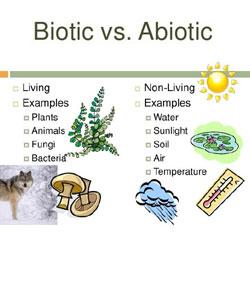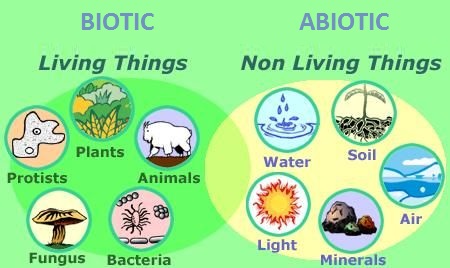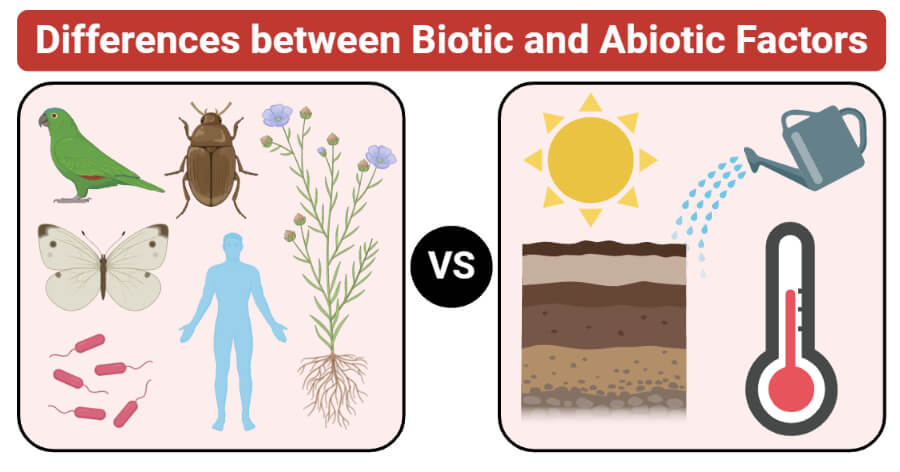7 Which of the Following Is Not an Abiotic Factor
Which of the following is an example of an abiotic factor. Thus option D is correct.

Abiotic Components Of Ecosystems Definition Examples Expii
Water sunlight soil oxygen and temperature.

. Plants is not an example of abiotic factors. Which of the following are biotic factors and which are. Sunlight water land temperature all constitutes the abiotic factors.
Perhaps the most important factor on the list in terms of the effect it has on an ecosystem the amount of sun energy that an ecosystem receives is vital to its character. The word biotic refers to having to do with living organisms. Five common abiotic factors are atmosphere chemical elements sunlighttemperature wind and water.
Biotic factors are living things within an ecosystem. Non-living components like sun water rocks temperature soil are abiotic components. Which of the following is not an abiotic factor.
Abiotic factors include water sunlight oxygen soil and temperature. The Himalayas lack the abiotic factorslike an arid climate and loose soilthat the snake is adapted to and the snake likely will not be able to survive. Abiotic factors include water sunlight oxygen soil and temperature.
A nonliving element in an ecosystem is an. Abiotic factors are the non-living parts of an environment such as sunlight temperature water soil wind etc. They refer to the biological component of the ecosystem consisting of a population of plants animals and micro-organisms in complex communities.
Is a fallen rotting tree considered an abiotic or biotic factor. Such as water soil and atmosphere. Which of the following is not considered as abiotic component of an ecosystem.
12 abiotic are the non living things. For example organisms such as plants and animals. Which of the following is not a biotic factor.
Other abiotic factors comprising the ecosystem include. The biotic factors influencing an organism viruses and other parasitic organisms cause diseases. Dead organisms are not abiotic.
There are two categories of these factors. In a terrestrial ecosystem examples might include temperature light and water. Non-living limiting factors or abiotic limiting factors include space water nutrients temperature climate and fire.
Our environment comprises of two factors namely biotic factors and abiotic factors. Lizards and cacti are biotic factors in a desert ecosystem that would rely on which abiotic factors. Altitude Abiotic factors are the non 6.
They were once living and so considered biotic. Abiotic components are made up of abiotic factors - which this hub is going to concentrate on - and are all non-living factors. Learn more about abiotic factors with this curated resource.
Abiotic factors are the non-living parts of the environment that can often have a major influence on living organisms. Water is a very important abiotic factor all living organisms need water. Which of the following are biotic.
Which of the following substances is cycled between organic matter and abiotic reservoirs. Which of the following is abiotic factor. In a marine ecosystem abiotic factors would include salinity and ocean currents.
The term abiotic refers to the non -living entities in the ecosystem. Biotic describes a living component of an ecosystem. Many factors affect the environment such as some factors determines how much the tree can grow why birds are migrating one place to another and where the plants and animals are found.
Biotic and abiotic factors are what make up ecosystems. An abiotic factor is a non-living part of an ecosystem that shapes its environment. Fungi are not abiotic.
Abiotic Components are the non- living parts of an ecosystem. Which of the following investigations is an example of the study of an abiotic factor. For starters we need oxygen to breatherespiration powers our cells.
A living or once-living organisms in an ecosystem is a. Which of the following is not an abiotic factor. Herbivores are the primary consumers that depend on plants for their food.
Whereas living organisms such as plants and animals are biotic components. Such as plants animals and bacteria while abiotic are non-living components. Which of the following ecological levels does not describe interacting biotic and abiotic factors in an area.
Each of the following is an abiotic factor in the environment except. Which is not an example of abiotic factor in the environment. The correct answer for Which of the following is not an example of an abiotic factor.
A limiting factor is any nutrient resource or interaction which puts an immediate limit on the growth of a population or individual. 10 both living and non living. Abiotic and biotic factors work together to create a unique ecosystem.
Which of the following is not an abiotic factor. What are the 5 abiotic factors. All of the living things in an ecosystem such as plants and animals that influence an ecosystem in any way are categorized as biotic factors.
There are mainly two types of factors that influence the environment are Biotic Abiotic Abiotic factors are referred. Humans like other animals also require certain abiotic factors to survive and live comfortably. 13 consumer not sure 14 mosquitoes.
Water H2O is a very important abiotic factor it is often said that water is life. Which of the following is not an example of an abiotic factor. 11 all of these.
Plants are not an example of an abiotic factor. Biotic factors are those in ecosystem that consists of all living organisms such as plants trees humans insects animals birds etc. All living organisms need water.
Examples Water light wind soil humidity minerals gases. 7 Which of the following is NOT an abiotic factor. Which statement best illustrates a biotic or an abiotic factor that is often found in a city park.

Biotic And Abiotic Factors Proprofs Quiz

Abiotic Factor Definition Meaning Dictionary Com

Biotic Vs Abiotic Factors Definition 10 Differences Examples
No comments for "7 Which of the Following Is Not an Abiotic Factor"
Post a Comment